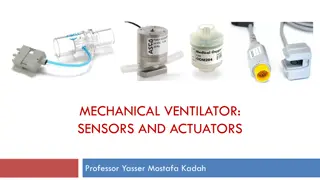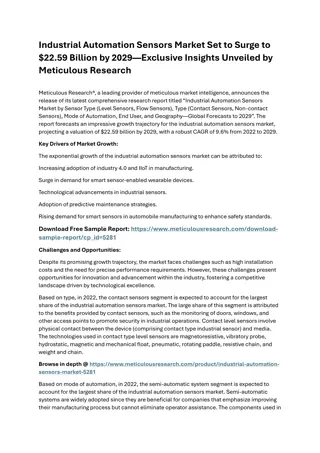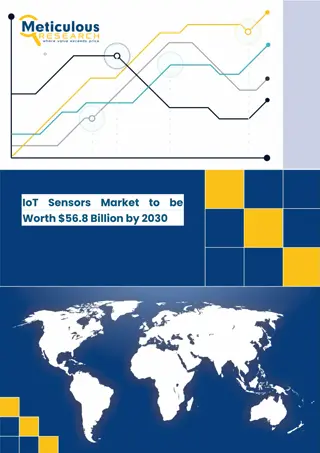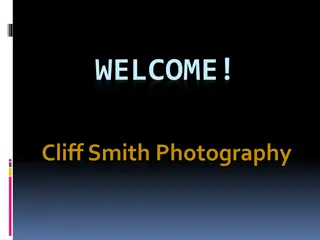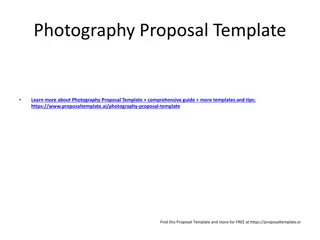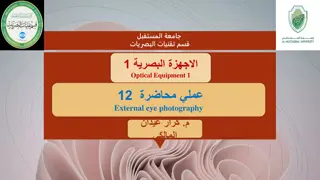Understanding High Dynamic Range Sensors in Computational Photography
Dive into the world of High Dynamic Range (HDR) sensors in computational photography with topics covering sensor architectures, CMOS sensing techniques, dynamic range evaluation, and basic concepts related to image sensors and pixel integrators. Explore the importance of dynamic range in capturing a wide range of intensities and shadow details in images.
Download Presentation

Please find below an Image/Link to download the presentation.
The content on the website is provided AS IS for your information and personal use only. It may not be sold, licensed, or shared on other websites without obtaining consent from the author. Download presentation by click this link. If you encounter any issues during the download, it is possible that the publisher has removed the file from their server.
E N D
Presentation Transcript
COMP790: Computational Photography High Dynamic Range Sensors Montek Singh Apr 1, 2019 1
Topics HW6 Quick overview of other HDR sensor architectures 2
Survey of HDR CMOS Sensing Techniques Author: Chih-Hao Sun Advisors: Montek Singh Leandra Vicci
Dynamic Range of Image Sensors 1 The range of light can be detected by image sensors in one exposure. v Dark Black Dynamic Range White Bright
Dynamic Range of Image Sensors 1 Without enough dynamic range: Lose shadow detail Either washed out highlights HDR can capture wider range of intensities
Dynamic Range of Image Sensors 1 The range of light can be detected by image sensors in one exposure. Dark Dynamic Range Bright LightDarkest LightBrightest To evaluate, dynamic range (DR) is computed as DR=logLightBrightest LightDarkest (number of bits)
In the following slides, the in-pixel integrator value is shown as increasing from 0 to 1. The actual voltage decreases from max to 0. But for presentation purposes, some people prefer showing an increasing accumulation. 7
Basic Concept 8 Light Output Shutter Switch Capacitor Digital Converter Probe Receptor Photocurrent Pixel Post-Processing Refresher Photocurrent (A) Dark Bright
Basic Concept 8 Light Output Shutter Switch Capacitor Digital Converter Probe Receptor Photocurrent Pixel Post-Processing Refresher Level of Capacitor Exposure Size of Capacitor Used as brightness of light Time Refresh Frame start Frame end
Basic Concept 8 Light Output Shutter Switch Capacitor Digital Converter Probe Receptor Photocurrent Pixel Post-Processing Refresher Saturation Saturation Level of Capacitor Exposure Size of Capacitor Used as brightness of light Saturating Light Time Refresh Frame start Frame end
Basic Concept 8 Light Output Shutter Switch Capacitor Digital Converter Probe Receptor Photocurrent Pixel Post-Processing Refresher Saturation Level of Capacitor Exposure Size Saturating Light Time Refresh Frame start Frame end
Possible Approaches 10 Larger capacitors to avoid saturations But lose lower end of the range ! Doesn t help Size of Capacitor Exposure Level Maximum Non-saturating Light Time Frame start Frame end
Possible Approaches 10 Larger capacitors to avoid saturations Shorter exposure for saturating light Exposure Size of Capacitor Level Maximum Non-saturating Light Time Frame start Frame end
Multiple Captures 12 Measure the level multiple times during an exposure. The distribution of capturing points can be uniform, exponential or be applied by any sampling methods. Size of Capacitor Level Time Frame start Frame end
Multiple Captures 13 Brightness is computed by using the time and the level of the last non-saturating capture. LevelProj=LevelLast TimeExp TimeLast Timelast Level Levellast Levellast Timelast Time Frame start Frame end
Multiple Captures 14 Dark Bright Dynamic Range First Capture Level Maximum Detectable Light Time Frame start Frame end
Multiple Captures 15 The Actual Dynamic Range Dark Bright Noise Noise Level Maximum Detectable Light Time Frame start Frame end
Multiple Captures 16 The accuracy of circuit becomes more important when detecting saturating light. ) TimeExp TimeLast ( LevelProj= LevelLast+NoiseLevel Level Levellast Timelast Time Frame start Frame end
Multiple Captures 16 The accuracy of circuit becomes more important when detecting saturating light. The information of the last non-saturating capture should be saved by extra in-pixel memories. Level Levellast Timelast Time Frame start Frame end
Time-to-Saturation 17 Measure the exact saturation time of saturating light for computing the final level. LevelProj=Size TimeExp Level TimeSat Size of Capacitor TimeSat Time Frame start Frame end
Time-to-Saturation 17 Measure the exact saturation time of saturating light for computing the final level. For non-saturating light, the level of capacitor is measured directly. Size of Capacitor Level of Capacitor Time Frame start Frame end
Time-to-Saturation 18 An in-pixel Time Integrator is implemented to measure the time from saturations to the end of exposure. Triggered when saturations happen. Level Level of Time Integrator Size of Capacitor Level of Time Integrator Level of Time Integrator Time Frame start Frame end
Time-to-Saturation 19 No limitation for maximum detectable light? Dark Bright Dynamic Range Level Level of Time Integrator Maximum Detectable Light Level of Time Integrator Time Frame start Frame end
Time-to-Saturation 19 No limitation for maximum detectable light? Dark Bright Dynamic Range Size of Capacitor Level of Time Integrator Exposu re Size Time Saturation Frame start Frame end
Time-to-Saturation 19 No limitation for maximum detectable light? Dark Bright Dynamic Range Size of Capacitor Level of Time Integrator Time Frame start Frame end
Time-to-Saturation 19 No limitation for maximum detectable light? Dark Bright The Actual Dynamic Range Noise Noise Size of Capacitor Level of Time Integrator Time Frame start Frame end
Time-to-Saturation 20 The accuracy of time integrator affects the correctness. TimeExp LevelProj=Size ( ) TimeSat+NoiseIntegrator The hardware complexity is increased due to an extra in-pixel Time Integrator.
Refreshing / resetting 21 The capacitor is refreshed multiple time during one exposure, virtually increasing the total size to avoid saturations. Level Size of Capacitor Refresh Refresh Refresh Refresh Refresh Refresh Reference Time Frame start Frame end
Refreshing 22 Instead of measuring the level of the capacitor, the number of refreshes is count by an extra in-pixel counter to decide brightness. Refresh Count Level Refresh Reference Time Frame start Frame end
Refreshing 23 Maximum detectable light is decided by the maximum count of refreshes and the Refresh Reference. Refresh Count Level Maximum Refreshes Refresh Reference Time Frame start Frame end
Refreshing 23 Maximum detectable light is decided by the maximum count of refreshes and the Refresh Reference. Also, there is a bound of minimum detectable light. Light which can t induce any refresh is not detectable. Level Minimum detectable Light Time Frame start Frame end
Refreshing 23 Maximum detectable light is decided by the maximum count of refreshes and the Refresh Reference. Also, there is a bound of minimum detectable light. Light which can t induce any refresh is not detectable. Dark Bright Dynamic Range One Refresh Max Refreshes
Refreshing 24 New residue error is introduced. An in-pixel counter increases the hardware complexity. Level Refresh Counts Real Brightness Refresh Reference Time Frame start Frame end



